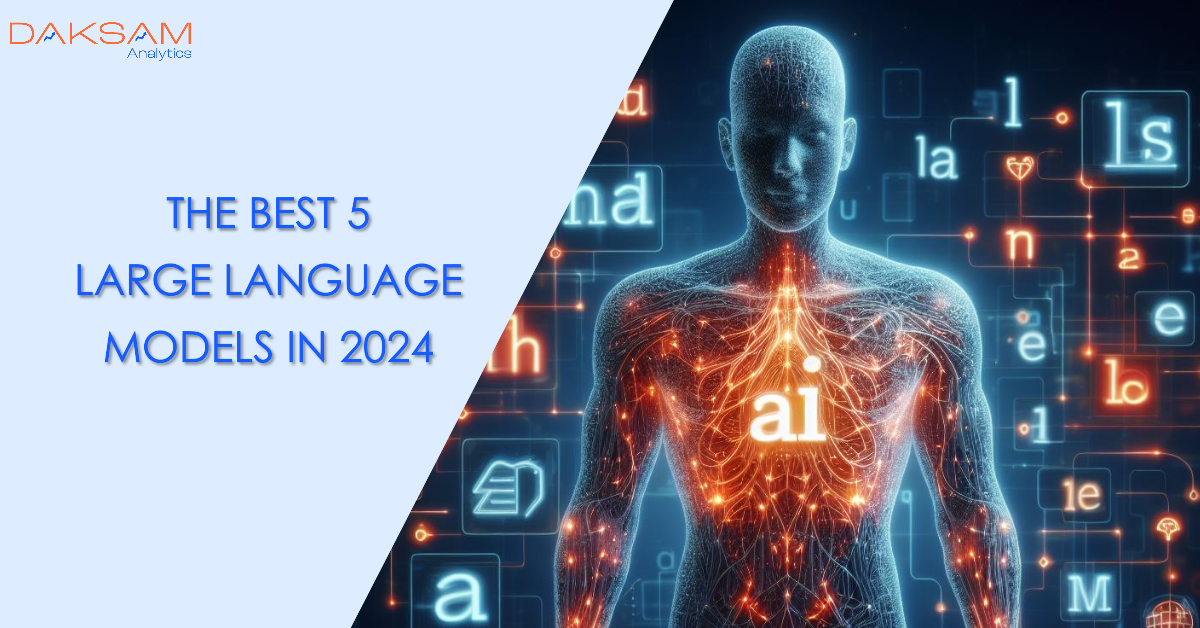The Best 5 Large Language Models in 2024

The history of large language models can be traced back to the 1950s when the field of AI was first established and the foundations of natural language processing (NLP) were laid. One of the earliest examples of a language model was ELIZA, a program developed by Joseph Weizenbaum at MIT in 1966. A large language model, or LLM, refers to a type of artificial intelligence model capable of understanding and generating human-like text on a vast scale. It's important to note that the exact origin or first usage of the term may not be easily pinpointed, as it likely emerged organically within the research and development communities working on language models. The term started to gain traction around the time that large-scale language models like OpenAI's GPT series began to emerge, which was roughly around 2018-2019. As these models became more prominent and their capabilities became increasingly recognized, the term "large language model" was coined to describe them.
In 2024, the landscape of large language models (LLMs) has expanded significantly, with numerous options available in the market. With such an availability of choices, deciding which LLM to utilize can be a daunting task. To assist in this decision-making process, we've compiled a list of the top five LLMs along with their core features, enabling you to make an informed choice based on your specific needs and preferences.
Top 5 LLMs in 2024
GPT4
Generative Pre-trained Transformer 4 (GPT-4) is a multimodal large language model created by OpenAI, and the fourth in its series of GPT foundation models. GPT-4 exhibits human-level performance on various professional and academic benchmarks.
Core Features
1. Creative Writing Abilities: GPT-4 excels in generating monotonous writing tasks such as crafting songs, scripting screenplays, and adapting to a user's unique writing style.
2. Enhanced Language Understanding: With refined language understanding capabilities, GPT-4 adeptly interprets complex text, providing more accurate and contextually appropriate responses.
3. Advanced Coding and Problem-Solving Skills: GPT-4 extends its utility beyond language tasks by demonstrating aptitude in coding and problem-solving scenarios, catering to a broader range of applications.
4. Accurate Description of Pictures: GPT-4 provides precise descriptions of images, seamlessly integrating visual information into textual contexts.
5. Suggestions and Advices in Real-time Scenario: In dynamic situations, GPT-4 offers timely and relevant suggestions and advice, enhancing user interactions and decision-making processes.
Claude
Claude is a group of large language models (LLMs) developed by Anthropic. Claude has some minor limitations when it comes to accessing the internet and extensions. However, Claude has built “Constitutional AI,” which allows developers to lay down a ‘constitution’ — a set of values that the system must follow. It’s pretty unique.
Core Features
1. Enhanced Processing: Claude can read up to 75,000 words at a time, enabling efficient handling of substantial amounts of information.
2. Engaging Responses: Thanks to its ethical and constitutional AI framework, Claude delivers more engaging and thoughtful responses.
3. File Handling Capability: Claude seamlessly integrates file handling within the chat interface, streamlining interactions.
4. Up-to-Date Information: With access to more recent data, up until December 2022 or early 2023, Claude ensures that responses are based on the latest available information.
5. Prioritizing Privacy and Safety: Claude places a strong emphasis on user privacy and safety, prioritizing these aspects throughout interactions.
Llama
LLaMA (Large Language Model Meta AI) is a family of autoregressive large language models (LLMs) released by Meta AI. It is an open-source large language model, free and available for research and commercial use. Numerous versions have been launched, such as LLaMA 2 and Purple LLaMA.
Core Features
1. Enhanced Coding Capacities: LLaMA offers features like code completion and debugging, enhancing coding efficiency.
2. Wide Range of Functions: LLaMA provides a diverse set of functions to cater to various needs and tasks.
3. Free and Open Source: It is freely available for both research and commercial use, as it is an open-source project.
4. Answers Trivia Questions: Effortlessly answer human-like trivia questions, showcasing its advanced language understanding capabilities.
5. Efficient Resource Usage: LLaMA requires less computing power, making it a cost-effective solution without compromising performance.
Gemma
Gemma is one of the latest introductions to Google's lineup of LLM models. Gemma is a family of lightweight, state-of-the-art open models that have been built using the same research and technology utilized in Gemini models by Google DeepMind and other teams across Google.
Core Features
1. User-Friendly Setup: Gemma is incredibly easy for developers to start with, as it comes pre- configured for use with Kaggle and Colab.
2. Human-Refined Model: With Gemma, a fine-tuned model is at your fingertips, incorporating valuable human feedback into its development.
3. AI Safeguard Toolkits: Gemma provides toolkits to ensure responsible and ethical AI usage, promoting safe and mindful development practices.
4. Integration with Popular Tools: By integrating with popular tools such as NVIDIA NeMo and TensorRTLLM, Gemma enhances its versatility and compatibility.
5. Optimized for Google Cloud: It is optimized for Google Cloud, ensuring efficient performance and scalability in cloud-based environments.
Falcon
Falcon LLM is a generative large language model (LLM) that helps advance applications and use cases to future-proof our world. It is developed by the UAE’s Technology Innovation Institute (TII).
Core Features
1. Unprecedented Scale: Falcon boasts training on over 1 trillion tokens and incorporates a staggering 40 billion parameters.
2. Enhanced Scalability: Featuring multi-query attention, Falcon achieves enhanced scalability, enabling efficient handling of large-scale tasks.
3. Streamlined Data Processing: Crafted using custom tooling and a unique data pipeline which makes it easy to extract valuable content from web data.
4. Open-Source: Falcon is not only advanced but also open-source, inviting collaboration and innovation from the broader community.
5. Top-rated by Hugging Face: Recognized as the top-rated Open LLM by HuggingFace, Falcon stands out as a benchmark in the field of large language models.
Conclusion:
The world of Large Language Models (LLMs) is vibrant and evolving, with each model bringing unique capabilities and advancements to the field of natural language processing. From the groundbreaking achievements of GPT-4 to the ethical considerations of Claude, the coding prowess of LLaMA, the user-friendly nature of Gemma, and the scalability of Falcon, these models showcase the diverse applications and potential of AI-driven text generation. As these models continue to mature and innovate, they promise to revolutionize how we communicate, create, and interact with AI, opening up new possibilities for creativity, efficiency, and understanding in the digital age.

